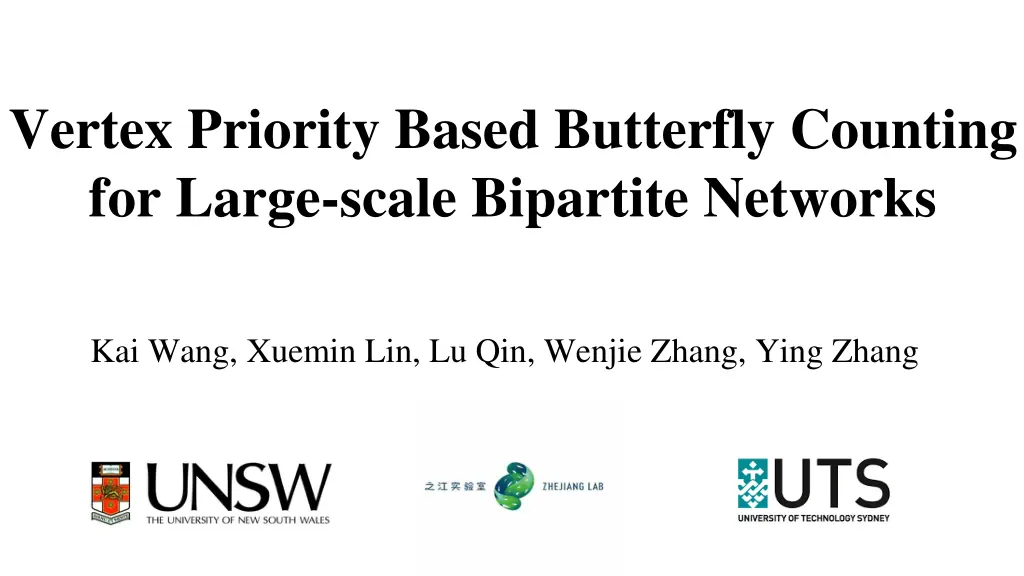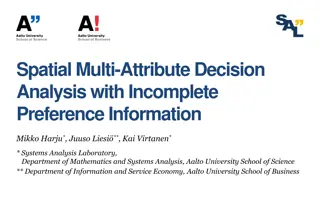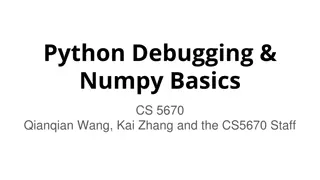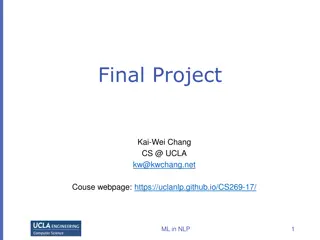
Vertex Priority Based Butterfly Counting for Large-scale Bipartite Networks
Explore the innovative approach of vertex priority based butterfly counting in large-scale bipartite networks. Learn about the computation of butterflies and its applications in graph analysis and community detection.
Download Presentation

Please find below an Image/Link to download the presentation.
The content on the website is provided AS IS for your information and personal use only. It may not be sold, licensed, or shared on other websites without obtaining consent from the author. If you encounter any issues during the download, it is possible that the publisher has removed the file from their server.
You are allowed to download the files provided on this website for personal or commercial use, subject to the condition that they are used lawfully. All files are the property of their respective owners.
The content on the website is provided AS IS for your information and personal use only. It may not be sold, licensed, or shared on other websites without obtaining consent from the author.
E N D
Presentation Transcript
Vertex Priority Based Butterfly Counting for Large-scale Bipartite Networks Kai Wang, Xuemin Lin, Lu Qin, Wenjie Zhang, Ying Zhang
Outline 1. Introduction 2. Solutions 3. Experiments 4. Conclusion 2
Introduction Bipartite network: (Adam) (Mark) (Shego) (Taylor) (Wine) (Carpet) (Balm) (Doll) (Hat) 3
Introduction The smallest non-trivial biclique: butterfly (Adam) (Mark) (Shego) (Taylor) (Wine) (Carpet) (Balm) (Doll) (Hat) 4
Introduction Butterfly counting: compute the number of butterflies in a bipartite graph G, denoted by ? (Adam) (Mark) (Shego) (Taylor) ? = 4 (Wine) (Carpet) (Balm) (Doll) (Hat) G 5
Introduction Butterfly counting: compute the number of butterflies in a bipartite graph G, denoted by ? (Adam) (Mark) (Shego) (Taylor) (Wine) (Carpet) (Balm) (Doll) (Hat) G 6
Introduction Butterfly counting: compute the number of butterflies in a bipartite graph G, denoted by ? (Adam) (Mark) (Shego) (Taylor) (Wine) (Carpet) (Balm) (Doll) (Hat) G 7
Introduction Butterfly counting: compute the number of butterflies in a bipartite graph G, denoted by ? (Adam) (Mark) (Shego) (Taylor) (Wine) (Carpet) (Balm) (Doll) (Hat) G 8
Introduction Butterfly counting: compute the number of butterflies in a bipartite graph G, denoted by ? (Adam) (Mark) (Shego) (Taylor) (Wine) (Carpet) (Balm) (Doll) (Hat) G 9
Applications 4 ? Bipartite clustering coefficient (c) ? = - the number of three-paths (computed in O(m)) Network measurement: high bipartite clustering coefficient indicates localized closeness; a building block for creating community structure [Aksoy et. al, 2017]. K-wing each edge in k-wing has at least k number of butterflies [Sar y ce et. al, 2018]. Community detection; word-document clustering; viral marketing ... 10
Related Works Unipartite networks - triangle counting: [1], [2], [3], [4], - other motifs: 4-vertices [5], 5-vertices [6], cycles of length k [7], Bipartite networks - butterfly counting: BFC-BS [8], BFC-IBS [9], State-of-the-art - other motifs: 3x3 biclique [10], 4-path [11], [1] M. Al Hasan and V. S. Dave. Triangle counting in large networks: a review. Wiley Interdisciplinary Reviews: Data Mining and Knowledge Discovery, 2018. [2] L. Becchetti, P. Boldi, C. Castillo, and A. Gionis. Efficient semi-streaming algorithms for local triangle counting in massive graphs. In KDD,2008. [3] L. Chang, C. Zhang, X. Lin, and L. Qin. Scalable top-k structural diversity search. In ICDE, 2017. [4] X. Hu, Y. Tao, and C.-W. Chung. Massive graph triangulation. In SIGMOD, 2013. [5] M. Jha, C. Seshadhri, and A. Pinar. Path sampling: A fast and provable method for estimating 4-vertex subgraph counts. In WWW, 2015. [6] A. Pinar, C. Seshadhri, and V. Vishal. Escape: Efficiently counting all 5-vertex subgraphs. In WWW, 2017. [7] N. Alon, R. Yuster, and U. Zwick. Finding and counting given length cycles. Algorithmica,1997. [8] J. Wang, A. W.-C. Fu, and J. Cheng. Rectangle counting in large bipartite graphs. In BigData Congress, 2014. [9] S.-V. Sanei-Mehri, A. E. Sariyuce, and S. Tirthapura. Butterfly counting in bipartite networks. In KDD, 2018. [10] S. P. Borgatti and M. G. Everett. Network analysis of 2-mode data. Social networks, 1997. [11] T. Opsahl. Triadic closure in two-mode networks: Redefining the global and local clustering coefficients. Social Networks, 2013. 11
State-of-the-art BFC-BS & BFC-IBS u0 u1 u2 u3 (Adam) (Mark) (Shego) (Taylor) BFC-IBS improves BFC-BS in three aspects: (1) pre-choose the layer of start-vertices to achieve a lower time complexity; (2) use a hash map to speed up the implementation. (3) avoid counting a butterfly twice (process the wedge (u, v, w) only if w.id > u.id) v0 v1 v2 v3 v4 (Wine) (Carpet) (Balm) (Doll) (Hat) 12
State-of-the-art BFC-BS & BFC-IBS u0 u1 u2 u3 (Adam) (Mark) (Shego) (Taylor) BFC-IBS improves BFC-BS in three aspects: (1) pre-choose the layer of start-vertices to achieve a lower time complexity; (2) use a hash map to speed up the implementation. (3) avoid counting a butterfly twice (process the wedge (u, v, w) only if w.id > u.id) v0 v1 v2 v3 v4 (Wine) (Carpet) (Balm) (Doll) (Hat) c(v0,v1)= 1 13
State-of-the-art BFC-BS & BFC-IBS u0 u1 u2 u3 (Adam) (Mark) (Shego) (Taylor) BFC-IBS improves BFC-BS in three aspects: (1) pre-choose the layer of start-vertices to achieve a lower time complexity; (2) use a hash map to speed up the implementation. (3) avoid counting a butterfly twice (process the wedge (u, v, w) only if w.id > u.id) v0 v1 v2 v3 v4 (Wine) (Carpet) (Balm) (Doll) (Hat) c(v0,v1)= 2 14
State-of-the-art BFC-BS & BFC-IBS u0 u1 u2 u3 (Adam) (Mark) (Shego) (Taylor) BFC-IBS improves BFC-BS in three aspects: (1) pre-choose the layer of start-vertices to achieve a lower time complexity; (2) use a hash map to speed up the implementation. (3) avoid counting a butterfly twice (process the wedge (u, v, w) only if w.id > u.id) v0 v1 v2 v3 v4 (Wine) (Carpet) (Balm) (Doll) (Hat) c(v0,v1)= 3 15
State-of-the-art BFC-BS & BFC-IBS u0 u1 u2 u3 (Adam) (Mark) (Shego) (Taylor) BFC-IBS improves BFC-BS in three aspects: (1) pre-choose the layer of start-vertices to achieve a lower time complexity; (2) use a hash map to speed up the implementation. (3) avoid counting a butterfly twice (process the wedge (u, v, w) only if w.id > u.id) v0 v1 v2 v3 v4 (Wine) (Carpet) (Balm) (Doll) (Hat) c(v0,v1)= 3 c(v0,v2)= 1 16
State-of-the-art BFC-BS & BFC-IBS u0 u1 u2 u3 (Adam) (Mark) (Shego) (Taylor) BFC-IBS improves BFC-BS in three aspects: (1) pre-choose the layer of start-vertices to achieve a lower time complexity; (2) use a hash map to speed up the implementation. (3) avoid counting a butterfly twice (process the wedge (u, v, w) only if w.id > u.id) v0 v1 v2 v3 v4 (Wine) (Carpet) (Balm) (Doll) (Hat) c(v0,v2)= 1c(v0,v3)= 1 c(v0,v1)= 3 = 3 + 0 + 0 = 3 v0 17
State-of-the-art BFC-BS & BFC-IBS u0 u1 u2 u3 (Adam) (Mark) (Shego) (Taylor) BFC-IBS improves BFC-BS in three aspects: (1) pre-choose the layer of start-vertices to achieve a lower time complexity; (2) use a hash map to speed up the implementation. (3) avoid counting a butterfly twice (process the wedge (u, v, w) only if w.id > u.id) v0 v1 v2 v3 v4 (Wine) (Carpet) (Balm) (Doll) (Hat) v1 v0 = 0 = 3 18
State-of-the-art BFC-BS & BFC-IBS u0 u1 u2 u3 (Adam) (Mark) (Shego) (Taylor) BFC-IBS improves BFC-BS in three aspects: (1) pre-choose the layer of start-vertices to achieve a lower time complexity; (2) use a hash map to speed up the implementation. (3) avoid counting a butterfly twice (process the wedge (u, v, w) only if w.id > u.id) v0 v1 v2 v3 v4 (Wine) c(v2,v3)= 2 = 0 v3 (Carpet) c(v2,v4)= 1 v3 (Balm) (Doll) (Hat) Time Complexity O(min{ u U(G)degG(u)2, v L(G)degG(v)2}) ? = 4 = 1 v1 v2 v0 = 0 = 3 = 0 19
State-of-the-art Issues in handling hub vertices: u0 u1 u2 u1000 u1001 L(G) R(G) v0 v1001 v999 v1000 v1 20
State-of-the-art Issues in handling hub vertices: u0 u1 u2 u1000 u1001 L(G) The existing algorithms need to go through u0 (or v1001) as the middle-vertex if choosing L(G) (or U(G)) to start. Regardless of whether the upper or the lower layer is selected to start, we must traverse totally C2, 1000 (= 499,500) plus 1,000 different wedges by the existing algorithms. R(G) v0 v1001 v999 v1000 v1 21
State-of-the-art Issues in handling hub vertices: u0 u1 u2 u1000 u1001 L(G) The existing algorithms need to go through u0 (or v1001) as the middle-vertex if choosing L(G) (or U(G)) to start. Regardless of whether the upper or the lower layer is selected to start, we must traverse totally C2, 1000 (= 499,500) plus 1,000 different wedges by the existing algorithms. R(G) v0 v1001 v999 v1000 v1 22
State-of-the-art Issues in handling hub vertices: u0 u1 u2 u1000 u1001 L(G) The existing algorithms need to go through u0 (or v1001) as the middle-vertex if choosing L(G) (or U(G)) to start. Regardless of whether the upper or the lower layer is selected to start, we must traverse totally C2, 1000 (= 499,500) plus 1,000 different wedges by the existing algorithms. R(G) v0 v1001 v999 v1000 v1 23
State-of-the-art Issues in handling hub vertices: u0 u1 u2 u1000 u1001 L(G) The existing algorithms need to go through u0 (or v1001) as the middle-vertex if choosing L(G) (or U(G)) to start. Regardless of whether the upper or the lower layer is selected to start, we must traverse totally C2, 1000 (= 499,500) plus 1,000 different wedges by the existing algorithms. R(G) v0 v1001 v999 v1000 v1 24
Challenges It is a challenge to effectively handle high-degree vertices. It is also a challenge to utilize CPU cache to speed up butterfly counting. 25
Solutions Solution 1: The vertex-priority-based algorithm BFC-VP, to conquer challenge 1 Solution 2: BFC-VP + cache aware techniques BFC-VP++, to conquer challenge 1 & 2 26
The vertex-priority-based algorithm Motivation: a hub vertex may not always necessary to become a middle-vertex in a wedge for the construction of a butterfly. [u0, v0, u1, v1] in the Figure can be constructed in two ways: 1) by the wedges (u0, v0, u1) and (u0, v1, u1), or 2) by the wedges (v0, u0, v1) and (v0, u1, v1). 27
The vertex-priority-based algorithm Assign a priority to each vertex. Traversal necessary wedges. Only process the wedges (u, v, w) with p(u) > p(v) & p(u) > p(w). Count butterflies. Time Complexity O( (u,v) E(G)min{degG(u), degG(v)}) 28
Cache aware techniques Cache aware wedge processing Cache aware graph projection Improve CPU cache performance, keep time complexity and space complexity unchanged. 29
Cache aware wedge processing The degree distribution of the end-vertex- accesses on Tracker by BFC-VP 79% of total accesses are accesses of low-degree vertices (i.e., degree < 500) Since the locality of accesses is a key aspect of improving the CPU cache performance, we hope the algorithm can access more high-degree vertices as end-vertices. 30
Cache aware wedge processing New wedge processing strategy: processing the wedges where the priorities of end-vertices are higher than the priorities of middle-vertices and start-vertices. We proved that the total access of end- vertices remaining unchanged - the time complexity unchanged. The degree distribution of the end-vertex- accesses on Tracker using new wedge processing strategy The percentage of accesses of high-degree vertices (i.e., degree > 2000) increases from 9% to 81%. 31
Cache aware graph projection Generally, vertices are sorted by their ids when storing in the buffer. Although end-vertices are mostly high-priority vertices, the distance between two end-vertices (e.g., v0 and v3) can be very long. 32
Extensions Counting the butterflies for each edge 33
Extensions Parallel butterfly counting shared memory parallelization Easily extern our algorithms into a parallel version using O(n*t+m) space. global data space local data space for thread 1 local data space for thread 2 local data space for thread 3 34
Extensions External memory butterfly counting 1. Process wedges based on our strategy. 2. For each wedge (u, v, w), store the vertex-pair (u, w) on disk. 3. Sequentially scan these vertex-pairs and for the vertex-pair (u, w), we count the occurrence of it and compute using the following lemma. ? 35
Experiments Datasets Algorithms: BFC-IBS Baseline, BFC-VP, BFC-VP++ 36
Performance Study Performance on different datasets 37
Performance Study Speedup Scalability 38
Performance Study Cache Statistics over Tracker Cache Statistics over Bi-twitter 39
Conclusion We propose a vertex-priority-based butterfly counting algorithm BFC- VP which can effectively handle high-degree vertices. We also propose the cache-aware butterfly counting algorithm BFC- VP++ which improves the CPU cache performance of BFC-VP with two cache-aware strategies. We conduct extensive experiments on real datasets and the result shows that our BFC-VP++ algorithm significantly outperforms the state-of-the-art algorithms. 40
End Thank You! Q&A 41

















